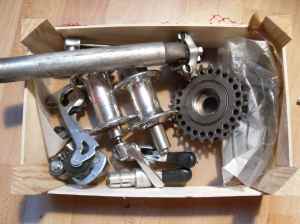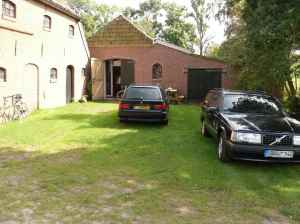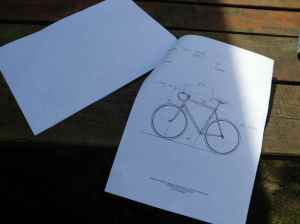 The other day a friend rang who had scored a Bickerton Portable MkII on the net and wanted to get rid of it as quickly as possible. Which should have made me think twice. However, being a fan of all bikes British, I went and bought it for a very moderate sum indeed. Which should have made me think twice over.
The other day a friend rang who had scored a Bickerton Portable MkII on the net and wanted to get rid of it as quickly as possible. Which should have made me think twice. However, being a fan of all bikes British, I went and bought it for a very moderate sum indeed. Which should have made me think twice over.
So, what about a Bickerton Portable? Checking things up on the net does not yield very substantial information, even the Wikipedia article is more than skinny. Made from alloy mostly. 10 kilos weight. Not bad.
Also, there´s a clip on youtube which shows Mr Bickerton himself arriving at a train station on one of his bikes at the same time as his train, he folds his bike down in a jiffy, and vanishes in the station, bike in hand, in time to catch his train. Great.
In the real world I had this heap lying in front of my garage and started to wonder.

Like that perhaps?
 And where is this going to go?
And where is this going to go?
 I have seen long saddle posts in my time, being 6″6´tall, but the Bickerton one beats them all.
I have seen long saddle posts in my time, being 6″6´tall, but the Bickerton one beats them all.
Just a few hours later: This is what I think it must be like.
 And what does it ride like? After pumping up the age old brittle tires as hard as I dared, I took my fate into my hands. Here´s what the cockpit looks like when in flight:
And what does it ride like? After pumping up the age old brittle tires as hard as I dared, I took my fate into my hands. Here´s what the cockpit looks like when in flight:
 Exactly my thoughts.
Exactly my thoughts.
The bike is definitively not for fast, spirited riding. Just look at those handlebars, the unbelievable seat pin – it all adds up to a feeling which can only be described as impossibly wobbly. You´re good when the bike takes you within about 10 or 20 degrees of where you point it. Still more unbelievably, the machine sports two different wheel sizes,


the smaller one being in front and not exactly adding to anything even remotely reminding of a stable ride.
But I doubt anyone in the seventies (the Bickerton was launched in 1971 according to some sources) would have noted. Those days were the low point of the bicycle as such, the only category cycles would be classed in was price point, hardly any good bikes were to be had anyway, and the car reigned supreme. The Bickerton was expressly made as a supplement to the car (or the train), so I suppose it wasn´t seen as the insult to serious cyclists that it must be perceived as being today.
El Cheapo
And cheap it is, truth be told. Look at this dropout end. Squashed tubing, no strengthening inside, full stop.
 Much was made in advertising from the fact that Mr Bickerton was an aircraft engineer – whatever that was supposed to mean. I guess I know now why I have an aversion to flying.
Much was made in advertising from the fact that Mr Bickerton was an aircraft engineer – whatever that was supposed to mean. I guess I know now why I have an aversion to flying.
Chromed steel rims, cheap plated and plasic covered q/r levers everywhere, but a min insert marking as a saving grace.

 Never heard of Ursuss with the double “S” – are they the Italian manufacturer of bike components who may have lost an S over the years?
Never heard of Ursuss with the double “S” – are they the Italian manufacturer of bike components who may have lost an S over the years?
 Cheapest German brand of pedals, too, plus a front hub (and front dropout) in the same vein.
Cheapest German brand of pedals, too, plus a front hub (and front dropout) in the same vein.
Also the chainset is the cheapest available given the large chainwheel size.

 The funny axle nut is there to catch the rear dropout end when the bike is folded, I think. In the manual it´s not described very in-depth – there´s mention of pushing the folded down handlebars until the catch frees the wheels.
The funny axle nut is there to catch the rear dropout end when the bike is folded, I think. In the manual it´s not described very in-depth – there´s mention of pushing the folded down handlebars until the catch frees the wheels.


 Also the construction as such is so very quirky, and definitively not made for prolonged serious use. Look at that brake bridge. Luckily my bike has a coaster brake, but just imagine a brake caliper hanging from it, and what it would do to the two small bolts attaching the bridge to the stays. Flexing is an understatement really.
Also the construction as such is so very quirky, and definitively not made for prolonged serious use. Look at that brake bridge. Luckily my bike has a coaster brake, but just imagine a brake caliper hanging from it, and what it would do to the two small bolts attaching the bridge to the stays. Flexing is an understatement really.
Or look at this cable clip. It moves when you look at it.

Lastly the saddle, which according to some illustrations on the net could well be original.

The wrench ingeniously suspended from it was put there by the former owner who obviously hadn´t understood the folding mech and undid all the nuts everytime.
So how does it fold?
You have this funny lever which has a flat surface into which a hook hooks. The hook is attached to one half of the central square tube, the lever to the other.
 You turn the lever to the left, the flat gives the hook a little play…
You turn the lever to the left, the flat gives the hook a little play…
 … which allows it to be swung out…
… which allows it to be swung out…

.. and the Bickerton becomes a folding bike. It has a hinge…

by the shape of which the bike can be indentified as a Mk II, BTW, and which is fixed to the tube by bolts, as is everything else. Bickerton prided himself by saying that he didn´t use a single weld on his bike.
 The tube doesn´t just consist of two empty halves, but the screwheads in the two faces of the folded frame insert themselves into the oposite face´s holes, giving at least some little strength to the construction.
The tube doesn´t just consist of two empty halves, but the screwheads in the two faces of the folded frame insert themselves into the oposite face´s holes, giving at least some little strength to the construction.

 But the quirkiness goes on.
But the quirkiness goes on.
One of the pedals must be removed in transit, so in order to facilitate removal it can be blocked with the help of a small plate, showing clearly that the pedals must be original:
 Now it´s free…
Now it´s free…
 … and now it´s blocked and can be unsrewed. When the bike is in transit, the pedal lives in the hole in the square main tube behind the seat tube, where, BTW, it sits very losely and to my mind is lost easily.
… and now it´s blocked and can be unsrewed. When the bike is in transit, the pedal lives in the hole in the square main tube behind the seat tube, where, BTW, it sits very losely and to my mind is lost easily.

It says in the manual not to forget to un-block the pedal when the bike is assembled, else the pedal is unscrewed when in use, but I´m not sure if the whole contraption would make today´s health and safety people happy. Also it says in the manual that the pedal doesn´t need to be screwed in the crank eye very tightly – I think that is so tell-tale with regards to what sort of use the Bickerton was meant for.
One more major headache is the complicated system of catches, safety tubes and springs which makes up the extension. (Note how the headset is plastic…)
 So once you have progressed this far, the handlebars must be folded down. Mr. Bickerton did invent a device that made folding during a ride impossible, but it´s also quite impossibly complicated to use when operating the folding mechanism.
So once you have progressed this far, the handlebars must be folded down. Mr. Bickerton did invent a device that made folding during a ride impossible, but it´s also quite impossibly complicated to use when operating the folding mechanism.




 Got it? No?
Got it? No?
See?
Let´s turn it round
Now the Bickerton from below.
 I really hope that the small bolt isn´t the only thing holding the b/b shell, but I wouldn´t be surprised if it were. Anyway the big hole is where the seat tube is attached.
I really hope that the small bolt isn´t the only thing holding the b/b shell, but I wouldn´t be surprised if it were. Anyway the big hole is where the seat tube is attached.
 This nice little plate sits on the underside of the square main tube right behind the steering head. Could anyone please explain how this bike came to be made in Australia? No mention of it I could find on the net. There´s another, different Australian plate on bickertonbicyclespares dot co dot UK (which site I am very much indebted to for much info in this blogpost), but no explanation is given as to where Bickertons were really built.
This nice little plate sits on the underside of the square main tube right behind the steering head. Could anyone please explain how this bike came to be made in Australia? No mention of it I could find on the net. There´s another, different Australian plate on bickertonbicyclespares dot co dot UK (which site I am very much indebted to for much info in this blogpost), but no explanation is given as to where Bickertons were really built.
What else?
I´m quite certain that mine was made for the German market, what with the dynamo lighting and the Shimano 3CC coaster hub,

 yes, the one with the cranked mech for which others just used a toggle chain,
yes, the one with the cranked mech for which others just used a toggle chain,
 because people here love their coaster brakes. But then, all of these items could have been retrofitted, of course.
because people here love their coaster brakes. But then, all of these items could have been retrofitted, of course.
When getting the bike a few days ago, I also was attracted to it because the whole drive train on my bike is like new, chain, sprocket, alloy chainwheel – what does that tell us?
Yes, you´re right. Think twice. But then again, every cyclist who owns bespoke or other great bikes should have a Bickerton just to remind him or her every now and then of how lucky they are.
Not getting rid of mine in a hurry.
 Parts are treated with flux, and then the brazing as such begins.
Parts are treated with flux, and then the brazing as such begins.




 I have to apologize about the quality of the photos, but I don´t have much time for editing these days. Take them as a first view, I can (and will) edit them later. Or retake in better weather.
I have to apologize about the quality of the photos, but I don´t have much time for editing these days. Take them as a first view, I can (and will) edit them later. Or retake in better weather.
























































































































































































































